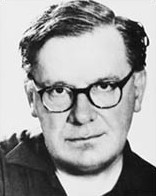Nikos Engonopoulos
Nikos Engonopoulos | |
|---|---|
| Νίκος Εγγονόπουλος | |
 | |
| Born | October 21, 1907 Athens, Greece |
| Died | October 31, 1985 (aged 78) |
| Nationality | Greek |
| Known for | Painting, poetry |
| Movement | Surrealism, Generation of the '30s |
Nikos Engonopoulos (Greek: Νίκος Εγγονόπουλος; October 21, 1907 – October 31, 1985) was a Greek painter and poet. He is one of the most important members of "Generation of the '30s",[1] as well as a major representative of the surrealist movement in Greece.[2] His work as a writer also includes critique and essays.
Biography
Nikos Engonopoulos was born in
In 1932 he joined the
His first paintings, mostly temperas on paper depicting old houses, were presented at an Art of Modern Greek Tradition exhibition, organised in January 1938.[4] Soon after the exhibition, he published translations of poems by Tristan Tzara, which were published in February. A few months later, his first collection of poems (Do Not Distract the Driver) was published, followed by a second one (The Clavicembalos of Silence) the next year.[4][2] Overall he is considered one of the finest surrealist poets of Greece.
Engonopoulos made his first individual exhibition in 1939.
He died of a heart attack in 1985 in Athens.[8] Engonopoulos was married twice; first he married the artist Nelly Andrikopoulou[9] from 1950 to 1954 and in 1960 till death he married Eleni Tsiokou with whom he had one daughter.[4]
Engonopoulos is considered as the introducer of the Greek surrealism and also its main representative. His works are noted for the combination of elements from tradition, history, religion and the contemporary period mixed with his own sarcastic attitude.[2][10] Engonopoulos' paintings are held in public and private collections such as the National Gallery of Greece, Benaki Museum, the Teloglion Fine Arts Foundation, the Museum of Modern Greek Art of Rhodes etc.[2][11][12][13]
See also
- Andreas Embirikos
- Art in modern Greece
- National Gallery of Greece
Notes
- ^ Eleni Kefala, Peripheral (Post) Modernity, Peter Lang, 2007, p. 160.
- ^ a b c d e f g h "Engonopoulos Nicos". National Gallery. Retrieved 2023-09-27.
- ^ Takis Mavrotas (ed.), Νίκος Εγγονόπουλος. Ο Ορφέας του Υπερρεαλισμού, The B & M Theocharakis Foundation for the Fine Arts and Music, 2022, p.137.
- ^ a b c d e f g "Biography - Engonopoulos". www.engonopoulos.gr. Retrieved 2023-09-27.
- ^ "Ο Νίκος Εγγονόπουλος μέσα από 140 σπάνια έργα του | LiFO". www.lifo.gr (in Greek). 2022-03-07. Retrieved 2023-09-28.
- ^ Takis Mavrotas (ed.), p. 30.
- ^ "Νίκος Εγγονόπουλος: Ο Τάκης Μαυρωτάς μας τον συστήνει με 10 έργα". AthensVoice (in Greek). 2022-03-04. Retrieved 2023-10-16.
- ^ Takis Mavrotas (ed.), p.140.
- ^ "Ψηφιακή Πλατφόρμα ΙΣΕΤ : Artists - Andrikopoulou Nelly". dp.iset.gr. Retrieved 2023-10-16.
- ^ Takis Mavrotas (ed.), p.27.
- ^ "Εσωτερικό σπιτιού στα Γιάννενα". The Benaki Museum (in Greek).
- ^ "The Foundation | Teloglion Foundation of Art A.U.Th". 2021-03-08. Archived from the original on 2021-03-08. Retrieved 2023-11-30.
- ^ "Συλλογή". Μουσείο Νεοελληνικής Τέχνης Δήμου Ρόδου (in Greek). Retrieved 2023-11-30.
Sources
- The Official Nikos Engonopoulos website
- Eleni Kefala, Peripheral (Post) Modernity, Peter Lang, 2007.
- Takis Mavrotas (ed.), Νίκος Εγγονόπουλος. Ο Ορφέας του Υπερρεαλισμού, The B & M Theocharakis Foundation for the Fine Arts and Music, 2022.
External links
- Engonopoulos, official site
- Poetry International Web - Article on Engonopoulos, by Haris Vlavianos. Also contains link to the full text of Bolivar.
- Artist's works
